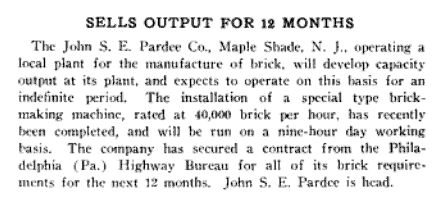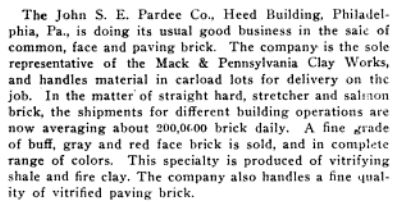Maple Shade, N.J. Brickyards Deed Histories
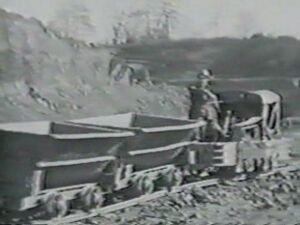
Rail Carts going to get filled.
|

Excavator
|

Filling carts with clay.
|
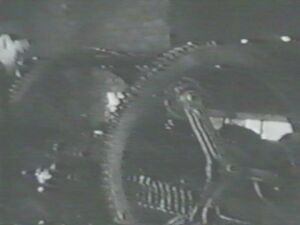
Machine forms clay into bricks.
|
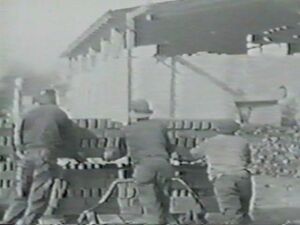
Workers moving bricks.
|
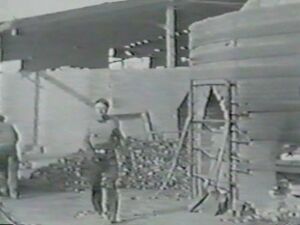
Worker passes a kiln oven.
|
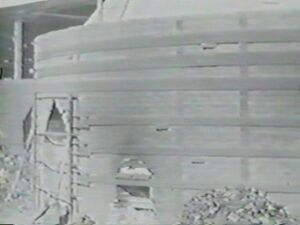
Kilns are large & domed shaped.
|
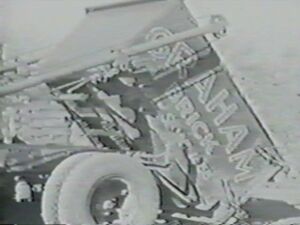
Truck tilts to pick up bricks.
|
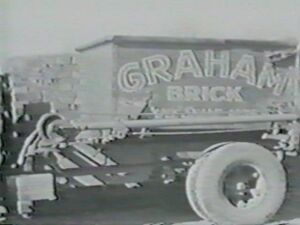
All photos are of Graham Brickyard.
|
A portion of the "Clay Pits" remain undeveloped today, as marsh land, east of N. Pine Ave. and south of the railroad tracks.
Below are some deed histories of the brickyard lands. Most town's people, even if they are too young of age to remember the Graham Brickyard which operated until 1956 when the clay supply was exhausted, know of the "Clay Pits" along the railroad tracks east of North Pine Ave.
The brick home on the north side of Main Street as you come up "Brickyard Hill," as some have called it in a past generation, into Maple Shade Township from Moorestown is another historical reminder. This was a once a double house where John Muffett and his son Robert Muffett lived. This yard was sold to Augustus Reeve and known as the Maple Shade Brickworks. Another product beside bricks was terra cotta sewer pipes and other terra cotta products.
The Depression ended the front brickyard land but the back brickyard, under Graham Brick Co., operated until 1956.
We will first list the back, and then list the front brickyard chain of titles.
Over the period of time the brickyards of Maple Shade were used, technology changed from primitive methods of digging the clay, stirring the clay, water and sand mixture by horses walking in a circle turning a pug mill and hand packing the clay into wooden molds to later using an excavator to dig the clay and machinery to mix the clay and cut the clay into bricks.
The brickyard land north of the railroad is today an industrial complex. Some of the brickyards' land was taken away for the making of S-41, now Route 73. I saw an old tax map that showed an old branch of the Pennsauken Creek that had been filled in or changed to straighten it. A portion of the "Clay Pits" remain undeveloped today, as upland marsh land, east of N. Pine Ave. and the railroad tracks.
During the digging of deep clay pits various small fossils were uncovered and the Philadelphia Natural Academy of Science made field trips to the site.
Area Brickyards Background-
The "Merchantville Clay Strata" runs along western NJ in Burlington and Camden County. It is a result of New Jersey being under water. You will have to ask someone like Hank Baron, a member of the Maple Shade Historical Society, for more information. In the clay, due to low oxygen exposure, etc..., fossils such as fossilized shells and sharks' teeth have been preserved.
In times past there have been small brickyards all about the area. There has also been bricks made for Quaker Meeting houses and old farmhouses obtained from clay dug up on someone's farm. There were three areas though where a lot of bricks came from for many years-
Pea Shore/ Fish House Station, Pennsauken, NJ
Fieldsboro/ Bordentown, NJ
Maple Shade, NJ
Pea Shore/ Fish House Station, Pennsauken, NJ-
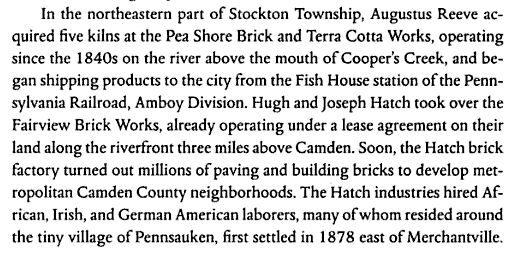
From a book about Camden County written by Jeffery M. Dorwart, 2001

From the Congressional Serial Set, issue 7147, 1916
Fieldsboro/ Bordentown, NJ-

1915 Sanborn map detail of William Graham's brickyard in Fieldsboro.
Map- Bordentown, Burlington County, NJ: including Fieldsboro (Sheet 13)

Church Brick Company ad from a Moorestown newspaper
The Church Brick Company, for a short time, had a branch in Maple Shade.
Maple Shade, NJ-

Ad from the Moorestown Chronicle Directory, 1907
|
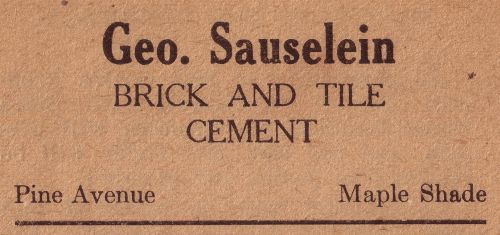
Ad from the Maple Shade Progress, 1917
|
Tha back brickyard, north of the railroad, was operated by the Sauselein family, then the William Graham Brick Co.
The front brickyard, south of the railroad, was run by Thomas Lippincott (also the back brickyard as there was no boundaries), John Muffett and Son, Augustus Reeve, John S.E. Pardee, and the Church Brick Co.
The rest of this report will focus on the brickyards that were at Maple Shade, NJ
The Number of People Employed by the Brickyards in Maple Shade-
(Note- John Pardee Yard unlisted for these particular years)
|
Pre Depression Years-
1901 Industrial Directory of New Jersey-
Brick, Augustus Reeve- employed 25 men
Brick, Theo. Sauselein- 10 men
1907 Industrial Directory of New Jersey-
Brick, Augustus Reeve- 25 m
Brick, Theo. Sauselein- 10 m
1915 Industrial Directory of New Jersey-
Reeve, common and fire brick- 45 persons
Sauselein, common brick- 12 persons
1918 Industrial Directory of New Jersey-
Reeve, common and fire brick- 45 persons
Sauselein, common brick- 5 persons
1927 Industrial Directory of New Jersey-
Church Brick Co., Plant No. 3, bricks, employs 30 males
|
Post Depression Start-
1934 Industrial Directory of New Jersey-
Graham, William, Brick Mfg. Co., common and face brick, 25 persons,
(the detail lists 35 persons not 25 and William Graham is Pres., L.J. Appleton is sec-treas.)
1940-41 Industrial Directory of New Jersey-
Graham, William, Brick Mfg. Co., common and face brick, 40 persons,
1943-44 Industrial Directory of New Jersey-
Graham, William, Brick Mfg. Co., common and face brick, 40 persons,
1946-47 Industrial Directory of New Jersey-
Graham, William, Brick Mfg. Co., face brick (colonial and textured), and common bricks, 35 persons
1949-50 Industrial Directory of New Jersey-
Graham, William, Brick Mfg. Co., face brick (colonial and textured), and common bricks, 35 persons
1956-57 Industrial Directory of New Jersey-
Brick, Wm. Graham, Pine Ave. & R.R., brick and hollow tile, m-28
|
The Back Brickyard, Lasted Until 1956-

The William Graham Brickyard was north of the railroad.
In this 1944 Sanborn map it has round drying kilns made of brick.
(Click on image for a larger image)
?
*****
Louis H. Gross, Marvin Kowit and Gabriel Berk, co- partners, parties.
took title on November 5, 1956
under deed book 1295 page 223
sold by William Graham Brick Manufacturing Co., a New Jersey corporation,
by Carl Z. Graham, L.J. Appleton, Helen Appleton, and Marion G. Robinson, Directors as Statutory trustees in Dissolution, parties.
Tract 1- 12.1821 acres
Tract 2- 0.640 acres
Tract 3- 1.356 acres
*****
|
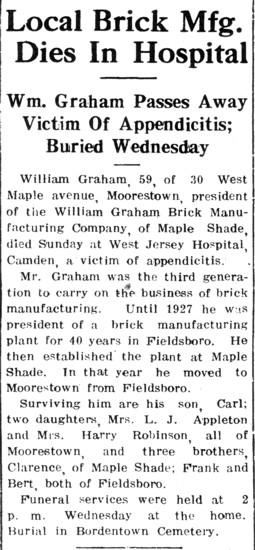
From the Maple Shade Progress,
April 11, 1935
(Click image for larger image)
|
William Graham Brick Manufacturing Co.-
William Graham Brick Manufacturing Co.
took title on April 7, 1926
under deed book 670 page 27
sold by William Graham and Susanna Graham, his wife
to lands formerly of Benjamin Stiles (later Horace Roberts), and lands formerly of Theodore Sauselein (now George G. Sauselein, Sr.)., corner of land of Ellena Sauselein Hagmaier (wife of John F. Hagmaier), point corner to VanGermert's land, to North Branch Pennsauken Creek.
*****
William Graham of Trenton, in the county of Mercer and State of New Jersey
took title on September 30, 1925
under deed book 655 page 404
sold by George B. Evans, and Geraldine A. Evans, his wife, of Moorestown, in the county of Burlington and State of New Jersey
(Note- George B. Evans was a lawyer who also dealt in Real Estate business)
*****
George B. Evans
took title on August 21, 1924
under deed book 632 page 273
sold by George G. Sauselein, Sr.
*****
George G. Sauselein Sr.
took title on September 4, 1915
under deed book 519 page 158
sold by Theodore Sauselein for one dollar
"all that certain tract or parcel of land and premises, situate at Maple Shade, in the Township of Chester, in the county of Burlington and State of New Jersey, BEGINNING at a stone in the northerly line of the right of way of the Camden and Burlington County Railroad at a point in the dividing line between the lands of Benjamin Stiles, now Horace Roberts and lands of Theodore Sauselein and extends thence ((1)(2)(3) degrees, minutes, etc...), to upper branch of Pennsauken Creek thence (4) up the middle line of said creek the various courses and distances thereof to the intersection of said line of said creek, with line of land now or late of Augustus Reeve, thence (5) Southwesterly along the dividing line between lands of the said Augustus Reeve and the said Theodore Sauselein of the right of way of the Camden and Burlington County Railroad and thence (6) Westwardly along the northly line of said right of way of the said Camden and Burlington County Rail Road Co., the distance what it may be to the place of beginning, BEING what is known as Sauselein Brick Yard."
*****
Sauselein Brickyard-
(Note- North Pine Ave. was previously named Sauselein Ave.)
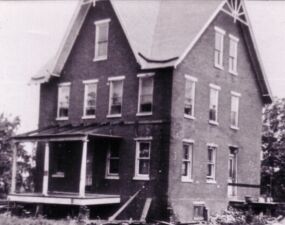

|
Theodore Sauselein Sr. purchased land on both sides of the railroad east of Pine Ave. He built a home and a slaughter house near the railroad. He later established the Sauselein Brickyard, which was north of the railroad tracks. (Information is from "Maple Shade A Story of 300 Years.")
His sons also built brick houses at 31 and 39 North Pine Ave. (Then Sauselein Lane). The photo to the top left is of one of the son's houses. Theodore Cash Sauselein finished his. George Sauselein never finished his front porch or steps so that the Tax Assessor could not assess it a completed house. (Thats what is written on the back of the photo.)
Thats either a joke or a shortlived truth because in the bottom photo are the two brother's houses with the front porches completed on both. These brick homes are no longer there. You can see Holly Ave. homes in the background.
(Click on the picture of the two houses for a larger image.)
|
|
From the book "Maple Shade A Story of Three Hundred Years" published by the Maple Shade Historical Society-
In 1897 Theodore Sr. established a second brickyard north of the railroad. Clay was dug by hand and loaded on carts, later on a line of carts hauled by a small engine on a narrow gauge railway, and taken to the forming shed. From there the raw bricks were taken to the huge dome- shaped kilns, baked for several days at high temperatures, and in a week were ready to be stored in the supply yard.
The second yard in the early 1900's was operated by Middlemiss. Both yards were supplied with clay dug from deep pits. When the pits were no longer used , they filled with water making excellent swimming holes in summer and skating ponds in winter.
|
Theodore Sauselein
took title on April 7, 1881
under deed book I 10 page 234 &c.
sold by Richard D. Jones
*****
Richard D. Jones
took title on March 22, 1877
under deed book M 9 page 393
sold by Joseph Walton and Lydia L. Walton his wife
for the sum of 4,500 dollars
47 acres and 60/100 of an acre
Being part of a larger tract of land which the said Lydia L. Walton (then Lippincott) became seized by virtue of a deed partition from under seals of Thomas Lippincott and Dinah his wife and Joseph W. Lippincott and Ann his wife in 1858.
*****
From a 1877 GM Hopkins map-
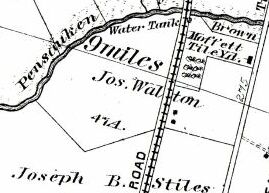
The above mentioned 47 acres would be the tract on map owned by Joseph Walton.
A County Plan Map showing the Proposed S-41 Highway going under the R.R.-

Besides the Depression, S-41, now Rt. 73, didn't help the brickyards!
The Front Brickyard, The Depression Ended It-
From the "Mineral Industry of NJ" for 1932, by Meredith E. Johnson, published in 1934-
The Maple Shade Brick Company, Maple Shade, has not operated for several years and probably will not be reopened.
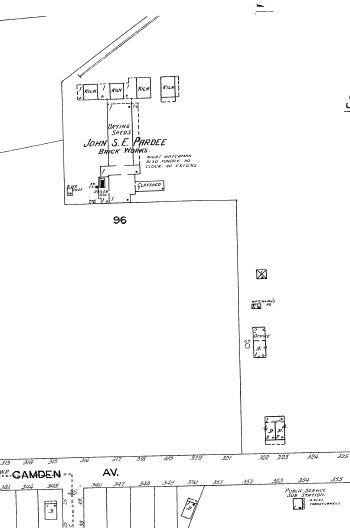
Augustus Reeve/ John Pardee Brickyard in 1923
|

John Pardee's Maple Shade Brick Co. yard in 1929.
North Boulevard Ave. with subdivision.
|
The Depression ended the front brickyard which John Pardee was then leasing to the Church Brick Company and the Main Street area brickyard land was not to be used again for such. The below 1941 Final Degree doesn't mean that it stayed open until then. Operations were stopped earlier.
The Township of Chester
took title on December 8, 1941
under deed book 939 page 291
In Chancery of New Jersey, Final Degree
The Township of Chester in the County of Burlington Complainant, and Maple Shade Brick Company, John S.E. Pardee Brick Company, Lydia B. Griscom, The Pennsylvania Company for Insurances on Lives and Granting Annuities, The American Oil Insurance Company, John S.E. Pardee, Ethel E. Pardee, and Ernest Nichols, Defendants.
*****
Two interesting deeds-
Rancocas Distilleries
took title in 1934
under deed book 835 page 165
sold by John S.E. Pardee
*****
The State of New Jersey
took title on June 13, 1930
under deed book 768 page 49
sold by the Maple Shade Brick Co.
John S.E. Pardee President, James S. Pardee Secretary
Something to do with State Highway S-41
(Note that John Pardee owns the Maple Shade Brick Company. This was the name that the John S.E. Pardee Brick Co. used.)
Church Brick Company-

From The Clay-worker, Volumes 85-86, page 63, 1926
|
They are still in business today, located in Bordentown, NJ. Below is a quote from their website (old version), churchbrick.com-
Thomas J. Church, LeRoy Church, Sr., and a few minor investors founded the Church Brick Company in 1916 and incorporated in the State of New Jersey in 1918. The first two brick plants were located in Fieldsboro, NJ and in the 1920's a third brick plant was purchased in Maple Shade, NJ. With the onset of the depression and having over three hundred employees on payroll, the company was forced to close one plant in Fieldsboro and the Maple Shade plant.
Church Brick Company's Short Time Leasing from John S.E. Pardee
(The title chain is written from beginning to end here-)
The Church Brick Company
on Nov. 17, 1925
under deed book 659 page 275
from John S.E. Pardee
agreed to Lease the land and buildings etc... for a ten-year lease agreement from Jan. 1, 1926 to December 31, 1936.
John S.E. Pardee known as Lesser and Church Brick Co. herein after called the Lessee.
*****
Church Brick Company
under deed book 721 page 355
November 15, 1928
from John S.E. Pardee
"That a lease agreement dated on the 17th day of Nov. 1925... has been surrendered and cancelled."
(another date- expires 3-18-28)
|

From the Maple Shade Progress,
August 29, 1935
(Click on image for a larger image)
|
John S.E. Pardee (Maple Shade Brick Company)-
An excerpt from Arthur Cutler's original Maple Shade story which was in the
Burlington County Realtor magazine, Spring 1955 issue-
The Burlington County Maps published in 1876 show the brickyard belonging to Joseph Walton located in the easterly end of Maple Shade. There was clay near to hand. This was put into a large drum, where it was mixed by horses on a treadmill. In later years, after the clay from the north side had been exhausted, a narrow gage track was put in and horses pulled carts of clay across from the pit on the south side of Main Street. The tracks still remain, where they can be seen crossing Main Street today. John Pardee was the last owner and operator of the yard.
|
Note- Take that information with a grain of salt. There is at least one error.
John S.E. Pardee
took title on February 15, 1921
under deed book 582 page 241
sold by William F. Reeve, Executor and Trustee
under Last Will and Testament of Augustus Reeve, deceased, and Elizabeth Cooper Reeve and Laura Reeve, two of the daughters of Augustus Reeve deceased, all of the City and County of Camden and State of New Jersey, parties of the first part, and John S.E. Pardee of the Borough of Collingswood in the County of Camden and State of New Jersey, party of the second part.
(Augustus Reeve died June 15, 1920)
First Tract- to Iron Bridge over Pennsauken Creek, corner Thomas Lippincott's land, Caleb Haines, Josiah H. Venable, containing 12 acres and 41/100 acres of land.
from Frank S. Marlor and Elener F. Marlor, his wife, March 10, 1890, under deed book 281 page 116 to Augustus Reeve.
Second Tract- meadow to George Brown's land along land late of Frank S. Marlor, Being the same premises which George Brown (widower) on March 18, 1890 under deed book 285 page 135 sold to Augustus Reeve.
Third Tract- from the Iron Bridge on the Camden Turnpike road to land of John R. Mason, Charles C. Haines, late William B. Haines, excepting thereout a lot of land containing one eighth of an acre of land known as the "Roberts Monument Lot" containing Twenty six acres and 81/100 of an acre, Being the same premises which John R. Mason and Margaret W. Mason his wife by deed dated March 17, 1900, deed book 344 page 337, conveyed unto Augustus Reeve.
Excepting out of the above tracts- First Tract- railroad to land of Theodore Sauselein, Second Tract- from Augustus Reeve to the Burlington County Railroad Co, on Jan. 12, 1912, book 476 page 250, Third Tract- Roberts Monument Lot.
(Take notice that the Maple Heights housing development begins with Boulevard Ave. BECAUSE the land to the east was once brickyard clay pits. The Maple Heights Land Co. took title on March 25, 1908, under deed book 430 page 266, sold by John R. Mason and Margaret his wife, who took title on March 25, 1867, under deed book P7 page 36, sold by Joseph W. Lippincott.)
There was also the C. Pardee Tile works in Perth Amboy NJ, established around 1890. The company manufactured front, fire, and paving brick, sewer pipe and a very limited amount of floor and glazed tiles.
|
The below photo and quoted information are from the book-
The Clays and Clay Industry of New Jersey
by Heinrich Ries and Henry B. Kummel, 1904
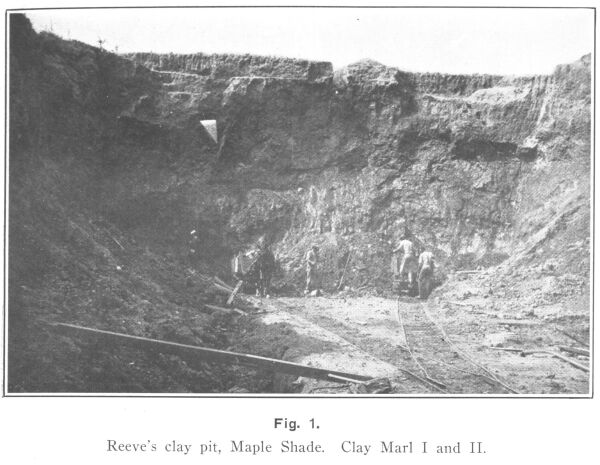
(Note the horse or mule pulling the clay cart on small gauge railroad tracks.)
(Click on image for a larger image)
|
Maple Shade- The same Clay Marl formation is worked by T. Sauselein, at Maple Shade (Loc. 150), on the north side of the railroad tracks. Here the beds are mostly weathered, but burn to a hard, red brick, and make a good product on stiff-mud machines.
On the south side of the railroad, and just south of the trolley road from Merchantville to Moorestown is A. Reeve's brick-clay pit (Loc. 149 Pl. XLI, Fig.1), but here the clay dug is at the line of contact between Clay Marl 1, and Clay Marl 2, both being used. The section exposed in 1902 was about thirty feet high and showed the following layers at the top:
Section in A. Reeve's clay pit, Maple Shade.
No. 1 Loamy gravel 2 ft.
(Start of Clay Marl 2-)
No. 2 Weathered clay, 8 ft.
No. 3 Black clay, 6 ft.
(Start of Clay Marl 1-)
No. 4 Greensand and clay, 6 ft.
No. 5 Black clay, 5 ft.
|
Augustus Reeve Brickyard (Maple Shade Brickworks)-
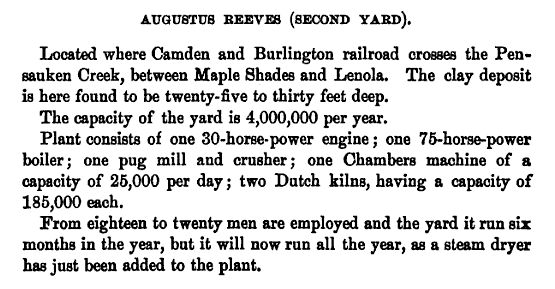
From the Final 1898 NJ Geological Survey
At right is a portrait of Augustus Reeve from the "History of Camden County, New Jersey" by George R Prowell, published in 1886. The book does not mention him having a brickyard in Maple Shade because he didn't yet.
|
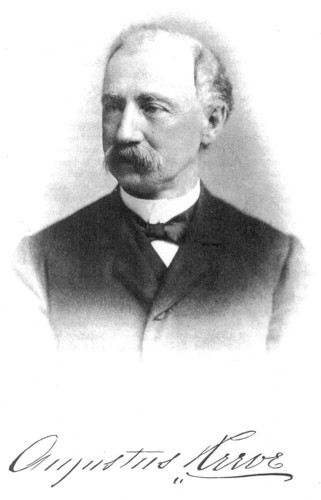
|
Augustus Reeve expanded the brickyard to include land on the south side of Main St.
South of Main Street-
*****
Augustus Reeve
took title on March 17, 1900
deed book 344 page 337
sold by John R. Mason and Margaret W. Mason his wife
from the Iron Bridge on the Camden Turnpike road to land of John R. Mason, Charles C. Haines, late William B. Haines, excepting thereout a lot of land containing one eighth of an acre of land known as the "Roberts Monument Lot" containing Twenty six acres and 81/100 of an acre
North of Main Street-
*****
Augustus Reeve
took title on March 10, 1890
under deed book 281 page 616
sold by Frank S. Marlor
for $8,641.24
Beginning stake middle of Moorestown & Camden Turnpike near the Iron Bridge over Pensauken Creek and corner of Thomas Lippincott's land and lands of Caleb Haines, and Josiah H. Venable, etc...
Containing 12 41/100 acres of land be the same more or less. Being the same premises which John Muffett and Mary Ann his wife and Mary Jane Muffett conveyed to the said Frank S. Marlor by deed dated July 31, 1888.
*****
Frank S. Marlor of the city of Philadelphia
took title on July 31, 1888
under deed book W 11 page 274
sold by John Muffett and Mary Ann his wife
for 1700 dollars
John F. Harned Master in Chancery, at Camden is where they appeared.
*****
Also found in the 1893-94 Boyd's Burlington County Directory under "Brick Makers"-
Reeve Augustus Maple Shade, Graham S. & Co. Bordentown & Fieldsborough, Graham Sylvester ____.
Augustus Reeve lived in a mansion in Camden, NJ. and also owned the Pea Shore Brick Works in Pennsauken. His son built a brick mansion on Main Street in Moorestown near the Moorestown- Mount Laurel Road traffic light on the north side.
|
An excerpt from "The Pennsauken Story" by Jack H. Fichter-
Augustus Reeve was born in 1833 and was the son of William and Mary W. Cooper Reeve. His parents were strict Quakers. In 1862 he married Rebecca, the daughter of Isaac H. and Elizabeth H. Cooper Wood. The newly wed couple were first cousins and direct descendants of Samuel and Elizabeth Coles.
In 1866 Augustus Reeve purchased the Pea Shore Brick Works and it became known as the Pea Shore Brick and Terra-Cotta Works.
|
John Muffett & Son Brick and Tile Yard-

The John and Robert Muffett Brick and Tile Yard house in 2006.
Now 919 East Main Street, Maple Shade, NJ, converted into a single house.
The Muffett's house was probably built in 1863 when they took title to the land. It doesn't appear on the 1860 Lake and Beers map. Nathan Pancoast who owned the Mecray Lane "John Stiles house" was married to Sarah Moffett. Is she related to them? Robert Moffett was living on or near the Joseph W. Lippincott farm as we see on the 1860 Census.
John and his son Robert Muffett's brick house on East Main Street is still there today. It was once a double house. The brickyard area can be found on the map of Chester Township in J.D. Scott's 1876 Illustrated Atlas of Burlington County and G.M. Hopkins 1877 Cinnaminson and Part of Chester area maps. The story according to the book "Maple Shade A Story of 300 Years" is that Joseph Walton was a brickmaker and made the brick house for Muffetts the foremen of his brickyard. That is incorrect and what happens when you draw a conclusion from a map alone. It is possible that Thomas Lippincott might have built the house for them.
The Muffett Brickyard was part of the original John Robert's land. (Some might have been Clark's which was very early purchased by the Roberts). Descendant William Roberts had a daughter, Hephzibah Roberts Lippincott, and a son John G. Roberts. The Lippincott couple bought the land from her brother lying on both sides of the Moorestown Camden Turnpike. She and husband Joseph B. Lippincott had several children. One was Joseph W. who farmed the Mason farm- Maple Heights land. One was Thomas who moved to Philadelphia and was a brickmaker. A daughter was Lydia who married Joseph Walton a cabinet maker.
Joseph and heiress Lydia L. Walton sold the land to John and Robert Muffett who already were living in the area, managing the brickyard years prior to buying it for themselves. The 1860 Chester Township census would indicate this as "John and Robert Moffett" are listed. Waltons are not, not even in a later Chester 1873 tax assessor's book of the Chesterford school district No. 27 tax area. There is on a GM Hopkins 1877 map two houses on Walton's land which doesn't include at the time the land of the "Moffett Tile Yard" with its house.
In "Moorestown and Her Neighbors" by James C. Purdy it has a mention of the "John Muffit & Son Brick & Tile Yard."
In George DeCou's 1929 book "Moorestown and Her Neighbors" we have this mention-
I regret that I cannot state definitely when the first brickyard was established near Moorestown. The present yards at Maple Shade, owned by the William Graham Brick Manufacturing Company, were conducted by John Moffit and Son in the 1880s. They were undoubtedly established at a much earlier date. Shark's teeth and sea fossils of various kinds are still dug up in the clay pits showing that this section was under water in pre-historic times.
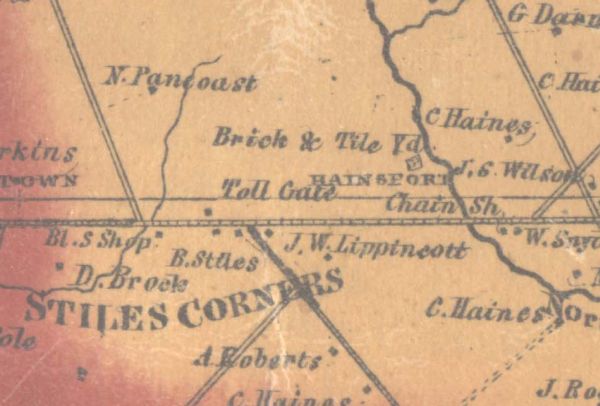
An 1860 Lake and Beers wall map shows a Brick & Tile Yard.
(This and the 1860 census with Robert Moffett listed as "Brickmaker"
correct any "bad history" that the R.R. brought the brickyards to Maple Shade)

The 1860 census shows Robert Moffett living in the vicinity of Joseph W. Lippincott.
Robert Muffett
took title on April 1, 1887
under deed book R 11 page 467
sold by John Muffett and Mary Ann his wife
for 2000 dollars
containing 12 acres of land and 40/100 of an acre.
Being the same tract that John Muffett and Robert Muffett became lawfully seized by virtue of a deed bargain and sale on July 25, 1863, sold by Joseph Walton and Lydia L. his wife.
*****
John Muffett
took title on July 25, 1863
under deed book J 6 page 276
sold by Joseph Walton of the city and county of Philadelphia, cabinet maker and Lydia L. his wife of the one part,
and John Muffett and Robert Muffett of the Township of Chester, county of Burlington, and state of New Jersey, brick makers of the other part.
for the sum of 1551 dollars and 25 cents for 12 acres and 41/100 of an acre.
*****
Lydia L. Walton then Lydia Lippincott
took title on May 20, 1859
under deed book I 6 page 616
sold by Thomas Lippincott and Dinah his wife, and Joseph W. Lippincott and Ann his wife.
*****
Maple Shade's First Known Brickmaker was Thomas Lippincott.
Thomas Lippincott grew up on the original Roberts land and left to live in Philadelphia. He probably learned brickmaking right on the property. Several nearby homes such as the Jeremiah Matlack home and later ones from his time probably got their bricks from along the creek there. His brother, Joseph W., inherited the "Mason Farm" land, and a sister and her husband the brickyard land(s), as he moved. Joseph W. Lippincott was involved in the placing of the Roberts Monument.
Lydia Lippincott
took title on December 22, 1858
under deed book I 6 page 616
sold by Thomas Lippincott of the city and county of Philadelphia, Brickmaker, and Dinah his wife, and Joseph W. Lippincott of the township of Chester and county of Burlington and state of New Jersey, Farmer, and Ann his wife, and Lydia Lippincott also of the town of Chester etc...
for the sum of one dollar for the tract of land and plantation , boundary lands of Thomas Lippincott and Benjamin Stiles, containing sixty acres and 2/100 of an acre, Being part of a larger tract of land which William Roberts of Chester died seized having made and published his last will and testament on 7-11-1829 willed described property unto his daughter Hephzibah, wife of Joseph B. Lippincott heirs. Their children were Lydia, Thomas, Edith (died), Ann?, Joseph W. Lippincott.
*****
Part of the "Roberts Family land"
owned by Joseph B. Lippincott, and Hephzibah Roberts Lippincott his wife
Their son Joseph W. Lippincott inherited the farmstead land south of Main Street
which was later the Mason farm, then a portion became Maple Heights.
The Joseph W. Lippincott information (to the right) is from the book- "American Ancestry: Embracing lineages from the whole of the United States. 1888-1898. Ed. by Frank Munsell, Thomas Patrick Hughes, J. Munsell's sons, 1890" pg. 147
From The Friend, Vol. 18, Third month 1845- Married at Friends' meeting-house, Frankford, on Fifth-day, the 6th instant, Thomas Lippincott, of Philadelphia, to Dinah, daughter of William Hilles, of the former place.
Thomas Lippincott shared a patent with James A. Hamer for an Improved Brick Mold. The patent was witnessed by a son, Hilles Lippincott. James Hamer had several patents earlier for brick molds, etc...
|

|
A Quote from the "Roberts Monument book"-
"The fact is, one day about two years ago, while I was in the office of our friend Joseph W. Lippincott on business, he said to me that he had something about which he wished very much to have a talk with me. He said that while he was farming the place which he heired from his father, he filled up what was then quite a deep hole in the ground, so as to be able to farm over the place. He said that that was the very spot where our mutual ancestors, John and Sarah Roberts, had lived in a cave or dugout when they first fixed their settlement on this continent. He said that he was very much afraid that the spot would be forgotten, and that I was a much younger man then he was, he would like for us to go out there some day and he would show me the exact place, then I might tell those yet younger than myself, so that the spot would not be forgotten."
(-Samuel M. Roberts, of Camden, N.J.)
Joseph Walton (Cabinet Maker)-
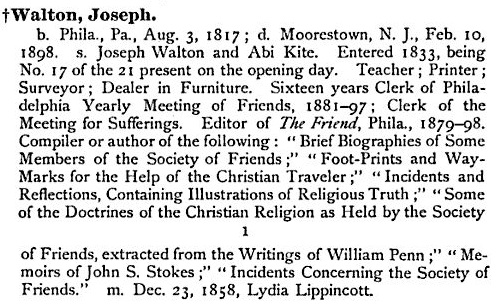
From the "Biographical catalogue of the matriculates of Haverford College: together with lists of the members of the college faculty and the managers, officers and recipients of honorary degrees, 1833-1900"
Joseph Walton (1817-1898) served as clerk of Arch Street Yearly Meeting from 1881 to 1896, a period of sixteen years.1 He had been in the furniture business in his early years, but turned more to Quaker concerns as he grew older...
-From the "Friends in the Delaware Valley: Philadelphia Yearly Meeting, 1681-1981"
|
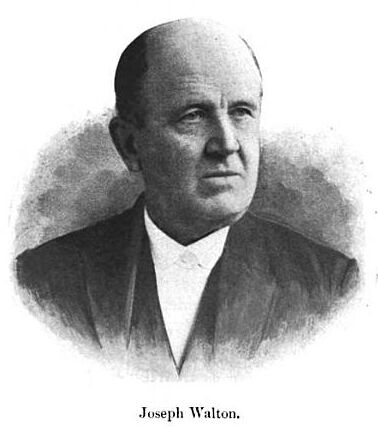
From the book- "Centennial history of Westtown Boarding School, 1799-1899 By Watson W. Dewees, Sarah Lovett (Brown) Dewees"
|
In the above deeds, Joseph Walton's trade is listed as a cabinet maker. Prior to that he was a school teacher. Later on, he became the editor of "The Friend" for the Arch Street Meeting House in Philadelphia.
Perhaps one would assume that the Lippincott family got Joseph Walton involved into brickmaking. They didn't. It is more probable that he got one of them, Joseph W. Lippincott, into cabinet making! He was interested though in the fossils which were unearthed at the clay pits.
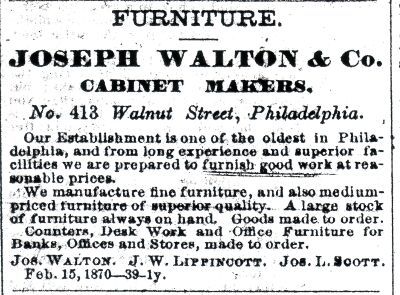
|

|
|
Advertisements found in The New Jersey Mirror newspaper on microfilm.
|
From a Sept 9, 1897 Trenton newspaper-

|
Joseph Walton was, in his later years, the Editor of the Orthodox Quaker periodical "The Friend" published for the Philadelphia Arch Street Meeting House.
MOORESTOWN FRIENDS CEMETERY
MAIN STREET
MOORESTOWN, NJ
WALTON
419. Joseph Walton Born 8th Mo. 4th 1817 Died 2nd Mo. 10th 1898
420. Lydia L. Walton Born 12th Mo. 17th 1811 Died 1st Mo. 24th 1901
421. Mary A. Walton Died 2nd Mo. 10 1879 Aged 82 Years & 5 Mo's
422. William Walton Born 12 Mo. 18, 1797 Died 9 Mo. 27, 1883
|
Interview with Horace J. Shiplee-
by Dennis Weaver on Sept. 12, 2004
Concerning his employment at the William Graham Brickyard.
(Note- He gives some incorrect information about clay, but besides that he gives many good details.)
1. When did you work at the brickyard?
I was 18 years old when I worked there for 6 months during the year of 1938 or 1939. I lived in Pennsauken, near the Camden border at the time. It was also about this time that I met my wife.
2. What did you do there?
I worked "on the line." The line was the clay being squeezed flat, going through a cutter and getting stamped then continued down a belt, where workers loaded the bricks onto carts. The metal carrier carts were 4 tiers or shelves high. They would be pushed into kiln ovens to bake the bricks.
3. (This one to Mrs. Shiplee)- Were the brickyards noisy?
No, they were quiet.
4. How many people worked there?
About 15 to 20 people.
5. Was it seasonal or year round work?
Year round.
6. Was William Graham the boss there then?
I don't remember the first name but a Graham was there as the boss.
7. Were the brickyards on the north or south side of the railroad tracks?
The north side where the present industrial complex now is.
8. Where was the William Graham Brickyard Office?
It was located on the brickyard site.
9. Do you know anything about the former yards of Augustus Reeve or Sauselein?
No, just that North Pine Ave. was then named Sauselein Lane and there were 2 brick houses (old Sauselein brick homes) still there north (should say south) of the railroad tracks, but I can't remember the exact spot where the were.
10. Who mostly bought the bricks?
Bricklayers. I don't know who because that was all in the office on the phone and not to do with me. Some customers picked up the bricks with a truck and some bricks were shipped out on railroad cars.
11. How deep were the deepest pits dug, like 60 feet?
No. Only 3- 4 feet down you got clay and that was only about 4-5 feet deep. The first foot or so of clay was bad because it had dirt and twigs and glaze in it. Clay needs to be somewhat near the ground surface to get moisture. Marsh land is where it is. The soil has to have a certain amount of water.
12. Iam surprised at how long they got clay out of the area.
Well they didn't gut it. You waited then went back to an area about 10 years later.
13. What kinds of bricks were produced?
Two kinds of bricks. Red and white bricks. The white bricks were sprinkled with a "certain type of white sand" that would turn them white. The clay before being baked in the kiln, or "mud" as it is called is a gray color. If you see green that is because leaves turned it that color. Some bricks were stamped with the name "Graham" on them, but not all.
14. Was was the brickmaking process?
They would clear the weeds, wet the ground down so it was muddy and not hard clay. The clay was then dug and loaded into rail carts, at just the right moisture. If it was too wet they would break it up to dry a little. If it is too wet then you can't make bricks because it is runny. The clay would go onto a belt where a 3 feet long squeezer roller compressed it to about 4 inches high by 8 inches wide then it would go through a machine that cut it with saws to brick width. The excess was used over. A stamp would crush it to finished size, with "Graham" if needed. The saw machine, belts, etc... were inside of a building. The bricks were loaded onto metal carriers, 4 tiers high and pushed into the kiln ovens to bake. The carrier carts were left in there loaded with bricks and wheeled back out when the bricks were done. The finished bricks were stored in a building until being shipped. They didn't stay there long because they made the bricks when they got orders for them.
15. Where were the kilns?
There were 3 kilns, located north of the railroad tracks where the industrial section now is. They were 60 feet square, made out of brick, and domed topped so that snow and rain would run off them. In other words the kilns were 20 feet high to the top and 20 feet wide. You would take 2 or 3 rack loads (carrier carts) in there and shut the door and seal it, then light it up. Charcoal was used for the fire with pipe lines in to carry the heat. You could put 4 or 5 tons of bricks in them.
16. How long did they stay in the kilns?
It was a slow process. 3-4 days of gentle heat then stay in there to a week or so baking at a higher temperature. The idea was to gradually increase the temperature or the bricks would crack. If they weren't gradually dryed and heated they would crack.
More information from Mrs. Shiplee on Sept. 18, 2004-
From Mrs. Shiplee- The white bricks were patio bricks and only 1/2 the thickness of the red ones. The Elite Bakery Building at Main Street and N. Pine was never connected with the brickyard. She lived on Sauselein Lane, now N. Pine Ave., as a girl in 1923. Trucks came down there a lot and crossed the railroad tracks to go to the brickyard. (can't do that now). As you come down from Main Street right about at the rear of the parking lot of the present Maple Hill Restaurant were the two Sauselein brothers brick houses on the right. Past that was a double frame house where she lived until her father built a house in Pennsauken where they moved to.
In 1923 the Graham brickyard was on fire. (Wooden kilns were probably still used then.) Her mother fried an egg and put it in bread and made her a sandwich to take outside and eat and watch the fire. Years later there was a second fire at the Graham brickyard. Mr.and Mrs. Shiplee moved to Maple Shade in 1941, but as you can see both had earlier ties to the town in that Mr. Shiplee had worked at Graham Brickyard and Mrs. Shiplee lived on Sauselein Lane as a girl.
Well, Thank you Mr. and Mrs. Shiplee for sharing this valued information of one of Maple Shade's past brickyards.
Home



























